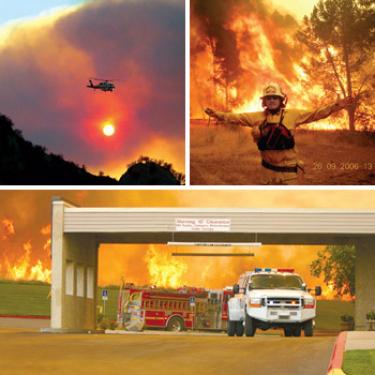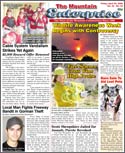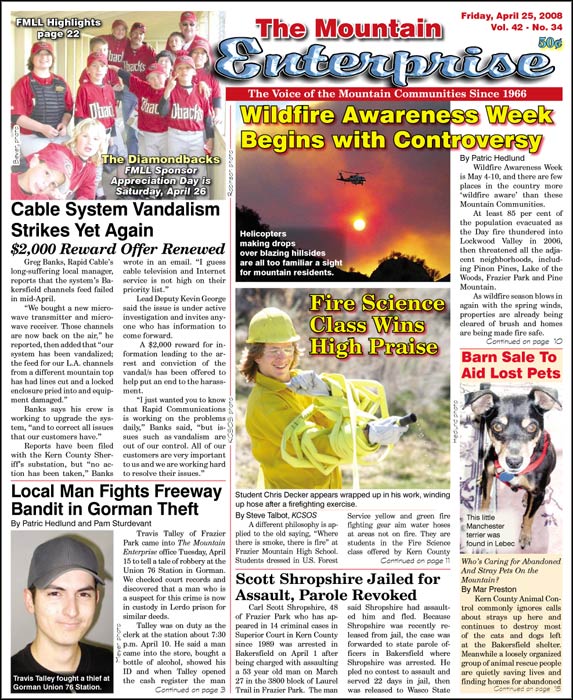
Top (l-r), Helicopters making drops over blazing hillsides are all too familiar a sight for mountain residents, Captain Randy Coleman of the Santa Barbara County Fire Department (who lives in Pine Mountain) was surrounded by towering whorls of flames during the Day fire?s entry into Lockwood Valley of 2006. Bottom, flames came right up to The Best Rest Inn and Flying J in Lebec during the Labor Day fire of 2005
By Patric Hedlund
Wildfire Awareness Week is May 4-10, and there are few places in the country more ‘wildfire aware’ than these Mountain Communities.
At least 85 per cent of the population evacuated as the Day fire thundered into Lockwood Valley in 2006, then threatened all the adjacent neighborhoods, including Pinon Pines, Lake of the Woods, Frazier Park and Pine Mountain.
As wildfire season blows in again with the spring winds, properties are already being cleared of brush and homes are being made fire safe.
So it was a surprise for members of the Mount Pinos Communities Fire Safe Council to hear from U.S. Forest Service Mount Pinos District Ranger Tom Kuekes that a plan to remove hazardous brush from around the Pine Mountain Learning Center may be held up by an organization called ForestWatch. He also said the group had objected to a plan to build a firebreak to protect the Pine Mountain community.
We contacted Jeff Kuyper, director of ForestWatch, to ask about the issue. He responded rapidly to say his group is in favor of programs to keep communities safe from wildfires.
"We don’t believe that it’s very productive to be playing politics with serious issues like community safety and the protection of our national forest. We support the creation of defensible space around schoolrooms, residences, and other structures—it’s the most efficient and effective way to protect our communities from wildfire. We have never opposed the removal of vegetation around the Pine Mountain Learning Center.
"As to impeding the thinning of fuel load adjacent to Pine Mountain, in 2004, the Forest Service first announced its plans to remove trees up to 30 inches in diameter and use a masticator to clear vegetation across 1,865 acres of national forest land, from the summit of Cerro Noroeste to Pine Mountain.
"We have never opposed any portion of the project near the Pine Mountain community. The concerns we have with this project are limited to two of the seven units of the project: Block A, a thinning proposal at the top of Cerro Noroeste; and Block B, a 500-foot-wide fuel break running along the northwest side of Cerro Noroeste. Both of these areas are far-removed from the community of Pine Mountain. We have no issues or concerns with the remaining 1,300 acres of this project that are adjacent to the community, and support proceeding with that work as approved.
"Creating defensible space around structures is the most sensible approach to wildfire protection in at-risk communities. On the other hand, clearing a 500-foot wide fuelbreak deep in the forest, away from communities, does not make sense from an economic, safety, or environmental standpoint. During these times of shrinking Forest Service budgets, it’s important that the agency use our tax dollars wisely and focus its efforts directly adjacent to communities, not far away from them and not deep in the national forest where the environmental harm may be significant," Kuyper concluded.
Mt. Pinos District Ranger Kuekes replied, "Forest Watch says they have only taken issue with the treatment units that are not immediately adjacent to private property, but the effect of their appeal is to halt the entire project. We have been funded this year to do 200 acres of fuel break construction and thinning which would be targeted at the areas closest to the Pine Mountain private property.
"Unless the appeal is resolved quickly and successfully, the money will go elsewhere and the work will not be done this year.
"It is Forest Watch’s absolute right to appeal any project. The Fire Safe Council at our meeting last week expressed concern about the local consequences from the appeal action.
The Forest Service disagrees strongly with Forest Watch’s contention that fuels projects are ineffective unless they are immediately adjacent to communities. The fuel treatment units (units A and B) that Forest Watch has expressed opposition to in the Pine Mountain project are only two miles or less from the Pine Mountain community and half a mile or less from Camp Condor.
Kuekes continued: "On large fires like the Day and the Zaca the planning horizon for each shift (24 hours) was about 10 miles out from the active fire, because fire can move that quickly in one day, and it takes time to construct and prepare fire lines and fire breaks before fire reaches communities.
"If we had treatments in place such as the ones proposed in the Pine Mountain project, it probably would not have been necessary to make the extraordinarily difficult decision to start bulldozing a fire line through the center of the Chumash wilderness as a last ditch effort to protect the community.
"It is far more effective and environmentally responsible to treat vegetation carefully, with protection measures in place, before a fire starts, than to start to run bulldozers all over the country once a smoke plume dominates the sky.
"Our Community Wildfire Protection Plan (CWPP), commissioned by the Fire Safe Council and endorsed by the Kern County fire department, Ventura County fire department, the Forest Service, and the Bureau of Land Management, lays out a menu of projects which, implemented in concert, will improve the fire safety of our mountain communities and the long term health of our wildlands.
"The Pine Mountain project which has been appealed by Forest Watch is one of the most important projects identified in the CWPP," Kuekes concluded.
Forest Watch’s Jeff Kuyper replied with photos to make his point that "there already is some level of protection around the school and community. So it’s not an ‘all-or-nothing’ scenario but an ‘all-or-something’ one."Kuyper sent photos from a USFS website [www.mtpinosfsc. org/our-projects.html] showing the "Charter School Shaded Fuel Break" project creating a fuel break along the road leading to the Pine Mountain Learning Center, located west of Pine Mountain off of Mil Potrero Highway.
The project made it possible, in the event of a wildfire for fire crews to protect the school and evacuate the students and staff. "You can see in the before and after pictures that the fuel load was significantly reduced, leaving many beautiful trees and eliminating the hazard. He also sent photos of the "Pinon Pines Shaded Fuel Break" and "Lake of the Woods Hazardous Fuel Clearance" project, all of which Forest Watch supports. Recently funded by the USFS, the LOW project will clear hazardous fuels from behind the community of Lake of the Woods.
Next week is Wildfire Awareness Week. We’ll bring you further information about the local Community Wildfire Protection Plan and an insert about what you can do to protect your home and family from wildfire.
This is part of the April 25, 2008 online edition of The Mountain Enterprise.
Have an opinion on this matter? We'd like to hear from you.


